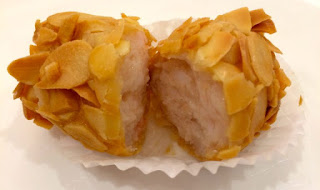While we have been to the usual trio of Vancouver dim sum of Dinesty (more of a soup dumpling place like DinTaiFung), Fisherman’s Terrace, and Sun Sui Wah, we wanted to try some place that does the usuals very well but also wasn’t afraid to have some new dishes like Koi Palace back in the Bay Area. We ended up at Chef Tony Seafood Restaurant. Located in a strip mall in Richmond, the outside looked like a run down 70s strip mall, the inside was more like the bar at the W. The usual dim sum staples were well done (which won’t be mentioned here), but they had some cool dishes we really enjoyed.
Creamy almond paste buns. Light and not too sweet almond cream paste in a bun. As light and ephemeral as Marzipan (which I also love) is heavy and substantive. A good in between of Marzipan and Annin tofu, in a bun.
Flaky almond meat loaf sticks. Tastes way better than the English translation sounds. Had no idea almonds went with mix of pork and shrimp.The usual tripe on the right. The left is egg plant with a meat ball on top. I actually liked it even though I am not an eggplant fan.
The usual shumai but with a fancy topping of black truffles. It smelled absolutely fantastic, made a regular dim sum staple more magical. The difference between a regular Ford Taurus and Taurus SHO.
I had hopes that the mushroom tart would be equal of Koi Palace’s abalone minced chicken tart, alas, it was not to be.
This artsy looking piece is the Longan jello with goji berries. Not too sweet, as a fan of longan, I can’t believe this isn’t at every dim sum restaurant.
Lastly, the fried taro with various fillings topped with an abalone. This was also quite good. Even without the abalone, the dish would have been great. Crispy on the outside, middle layer of soft taro, and fillings on the inside. Mmm…


































